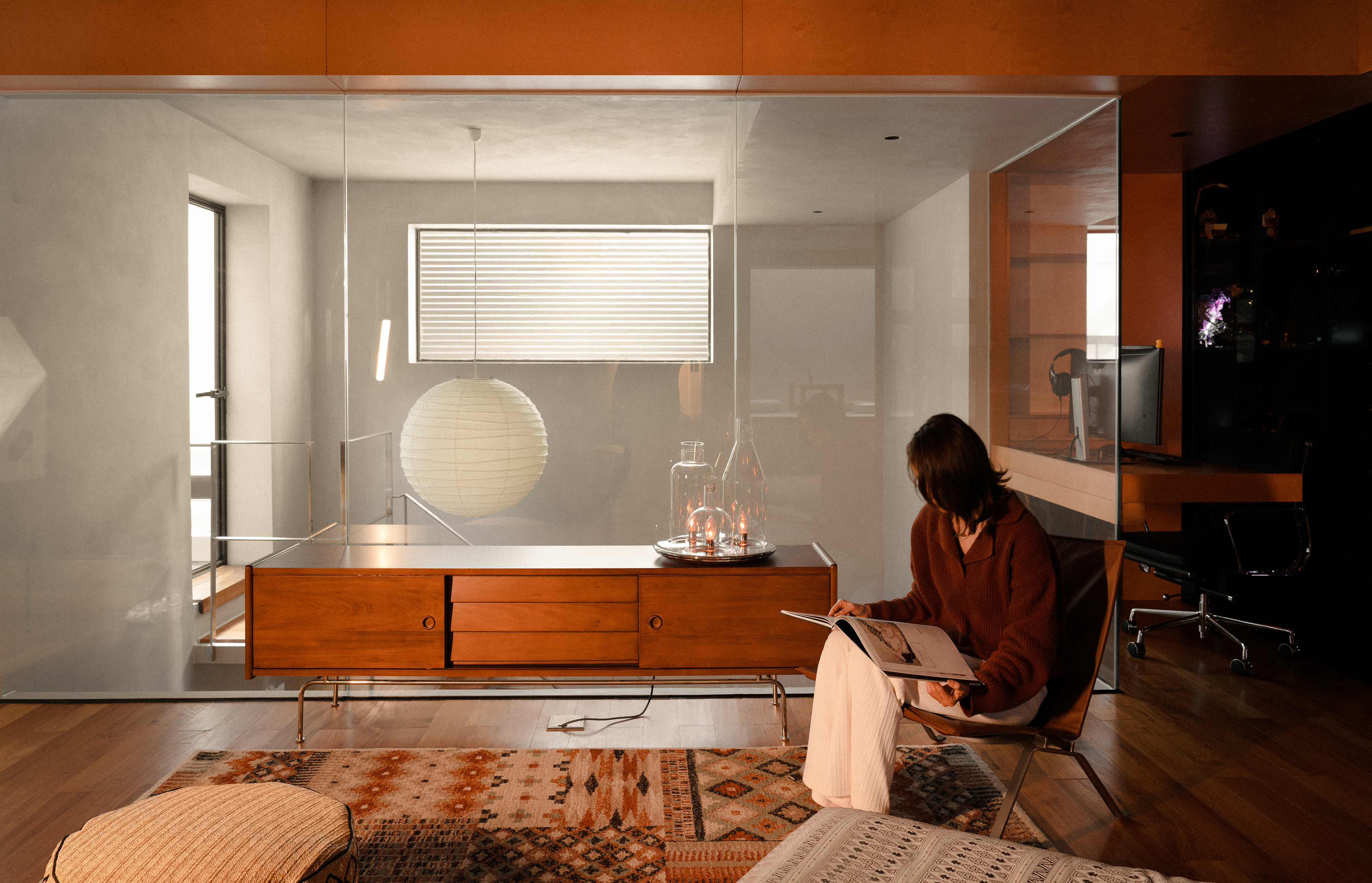

设计单位 上海几言设计研究室
项目地点 中国昆明
完工时间 2023年
建筑面积 280平方米
本文文字由设计单位提供。
对大多数忙碌的城市居民而言,回归大自然是告别喧嚣和寻求治愈的一种方式;而有些幸运者,则努力将自己的家变成身心的庇护所。因此,如何在家达到回归自然的效果成为新的设计课题。
For most busy urban residents, returning to nature is a way to bid farewell to the hustle and bustle and seek healing; while some fortunate individuals strive to turn their homes into sanctuaries for the mind and body. Therefore, how to achieve the effect of returning to nature at home has become a new design challenge.
本项目位于春城昆明的一处下叠墅,设计师接受本次远距离小宅委托,是因为与业主在对混凝土住宅的钟爱上不谋而合。设计师偏好天然材质及简约实用空间,希望突破传统设计思维,打造一个度假屋般静谧而舒适的家;也希望业主在忙碌的工作之余能有一个安静内敛气质的空间与家人相伴,听黑胶、阅书籍。
This project is located in a stacked villa in Kunming, the Spring City. The designer accepted this commission for a small residence from a remote location, coinciding with the owner's love for concrete houses and a desire for natural materials and practical minimalist spaces, daring to break through traditional design thinking, hoping to create a serene and comfortable home like a vacation home. The hope is to have a quiet and introverted space after busy work, accompanied by family, listening to vinyl records, reading book.
▲ 项目视频 ©几言设计

这个项目与大部分下叠住宅产品存在许多共性不足:楼层竖向交通拥挤、交互性弱,单层面积平面自由度差,地下空间大而空,采光通风不佳。应对此类住宅,简单的装饰美化是不够的。设计师一方面需要重新打造家的秩序感,同时还需要克制有效地创造一种真实内在的治愈庇护感。
This project shares common shortcomings with most stacked residential products we encounter: multiple floors with congested vertical traffic and weak interaction, limited freedom in single-floor area layouts, and large but poorly lit and ventilated underground spaces. The designer believes that simple decoration and beautification are not enough to address these residential issues. On the one hand, we need to redefine the order of the home, while effectively creating a sense of genuine internal healing sanctuary is the focus of this design.

小房子里造建筑
Building Architecture within a Small House
应对这类问题住宅,设计师第一层面的思考是正骨重塑,注重多层空间多层变化中的情绪感受。关键词:惊喜、变化、庇护。这包括营造从归家的惊喜,到楼层转换的丰富变化,再到最后归到起居空间庇护的内向思考。
In response to these residential issues, the designer's first consideration is structural reshaping, emphasizing the emotional experience of multi-level spaces and changes. Keywords: surprise, change, sanctuary. Creating surprises from returning home, to rich changes in floor transitions, and finally returning to the inward contemplation of living spaces.
首先,设计师对整体空间功能进行了重新梳理:负二层为门厅生活整理区,负一层为家庭娱乐区,一楼为生活茶歇,二楼为起居休闲,各楼层功能清晰,侧重有序。
Firstly, we reorganized the overall spatial functions: B2 for foyer and living organization, B1 for family entertainment, 1F for living and tea break, and 2F for living and leisure. The functions of each floor are clear and orderly.



原有的交通拥挤昏暗,严重影响了功能布置。因此,设计师重构了楼梯动线:新的楼梯将竖向空间营造成环绕拥抱的动线状态,不同楼层之间的楼梯转换伴随着场景的变化而变化。楼梯不再是简单的交通属性,而是伴随着人交互体验的空间装置。考虑到家有老人,设计师在有限的空间里加入了电梯。
The original congested and dim vertical traffic severely affected the functional layout, so we restructured the staircase circulation. The new staircase creates a dynamic state resembling a surrounding embrace, with stair transitions between different floors changing along with the scene. The staircase is no longer simply a transportation attribute but a spatial installation accompanied by interactive experiences with people. Considering the presence of elderly family members, we added an elevator in the limited space.



高空间给人松弛气度,但原有二层空间由于退让一层挑高造成空间使用过于紧凑。设计师希望在确保小家使用舒适性的同时,兼顾整体大空间氛围。于是,设计师在二楼植入了一个悬浮的木头盒子。它不仅在功能上为家人提供了起居陪伴的庇护所,同时也是整体空间的视觉焦点,营造出包裹有度的空间状态。
High spaces provide relaxation, but the original second-floor space became too compact due to the height increase on the first floor. We hoped to balance the comfort of small-scale use with the overall atmosphere of the large space. Therefore, we introduced a suspended wooden box on the second floor to function as a sanctuary for family living companionship. Additionally, the wooden box serves as a visual focal point for the entire space, creating a wrapped-up spatial state.

内敛的阴翳之美
Subdued Beauty in Shadow
安静内敛的庇护氛围是本次设计的重点思考课题,设计师对功能需求进行高效地规制,为空间释放更多的空阔感。
Creating a quiet and introverted sanctuary atmosphere is the focus of this project. We efficiently regulated functional requirements to release more spaciousness in the space.
在材料上,设计师选用拙性天然的材料,全屋主要材料只有3到4种。室内大量运用清水模,这种材质能给人提供一种松弛感和反差感。整屋桦木染色搭配天然柚木,既保持了色彩的统一性,又通过深色调和光影的结合,营造出一种包容而内敛的阴影氛围。
Simultaneously, in terms of materials, we meticulously selected natural materials with a rustic feel. The main materials used throughout the house are only 3-4 types, with a predominant use of fair-faced concrete. Concrete provides a contrasting sense of relaxation, while the entire house is matched with rare natural teakwood, maintaining unity while the dark space tone combined with light and shadow creates an inclusive and introverted shadowy atmosphere.





这是一个不大的清水模小木屋,一步一影一光阴。家的温度不仅在于空间和人,更重要的是身在其中时内心的安宁。
This is a small Concrete wooden house, step by step, shadow by shadow, moment by moment, the warmth of home lies not only in space and people but more importantly in the inner peace born within it.




设计图纸 ▽




完整项目信息
设计单位:上海几言设计研究室
项目地点:昆明
完工时间:2023年
建筑面积:280平方米
主案设计师:颜小剑
参与设计师:韦唯
软装设计:韦唯
主要材料:清水混凝土、柚木、染色桦木板、不锈钢
摄影师:卢思晗
版权声明:本文由上海几言设计研究室授权发布。欢迎转发,禁止以有方编辑版本转载。
投稿邮箱:media@archiposition.com
上一篇:西安之仓咖啡厅 / MOS木石设计
下一篇:奥雅纳×奥雷·舍人×福斯特×KPF:构建未来科创社区(下)